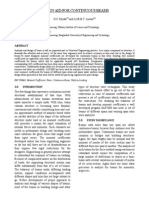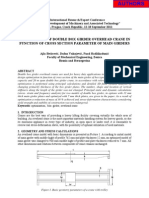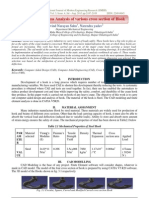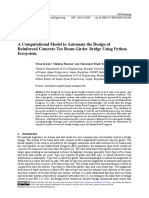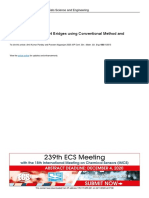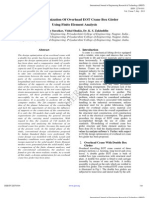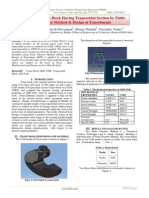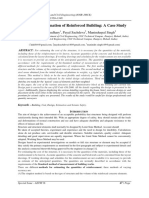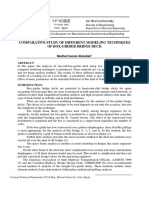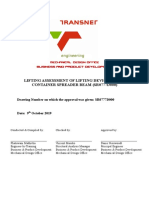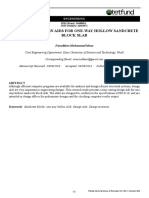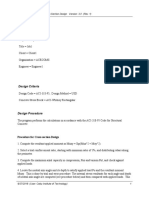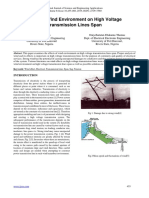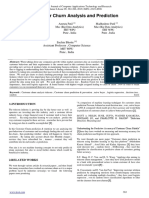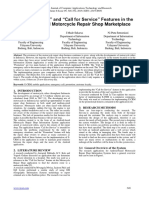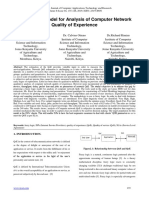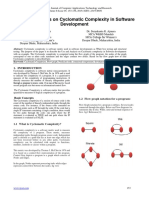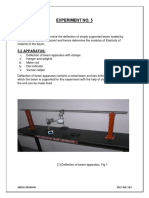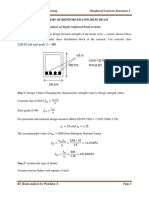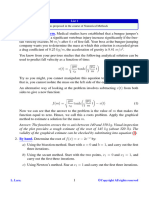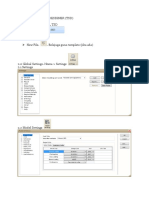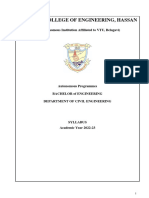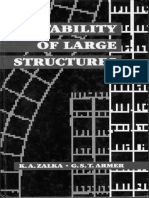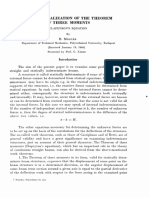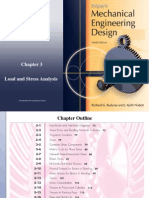Design Optimization of Floor Cranes
Design Optimization of Floor Cranes
Uploaded by
ATSCopyright:
Available Formats
Design Optimization of Floor Cranes
Design Optimization of Floor Cranes
Uploaded by
ATSOriginal Title
Copyright
Available Formats
Share this document
Did you find this document useful?
Is this content inappropriate?
Copyright:
Available Formats
Design Optimization of Floor Cranes
Design Optimization of Floor Cranes
Uploaded by
ATSCopyright:
Available Formats
International Journal of Science and Engineering Applications
Volume 3 Issue 5, 2014, ISSN-2319-7560 (Online)
Design optimization of Floor Cranes
A. Balaji
Department of Mechatronics
Engineering
Kongu Engineering College
Erode, India
H. Jahir Hussain
Department of Mechatronics
Engineering
Kongu Engineering College
Erode, India
M.R. Faheem Ashkar
Department of Mechatronics
Engineering
Kongu Engineering College
Erode, India
Abstract: This paper inculcates a way to make the floor crane as more efficient with less material requirement. This has been achieved
by minimizing reach of the crane from the floor. The crane is assumed to be cantilever type. Also tension and acceleration in steel
ropes are analysed to ensure the safety. The optimized crane successfully passed the various analysing tests which include deflection,
bending moment, rope tension and acceleration of the loads in the rope. It also includes another method which provides the virtual user
interface for the design engineer. By providing the crane dimensions in the virtual panel, the predefined program automatically creates
the CAD modelling in the CAD software. The program is made with visual studio and Solid works macro. Finally, this work reduces
the burden on the design engineer and increases the productivity.
Keywords: cranes; floor cranes; optimization; virtual CAD model; solid works
1. INTRODUCTION
3. VIRTUL CAD MODELING
A crane is a machine which is used in material handling
processes. It is used to lift, lower and move any materials
horizontally[1]. Cranes are used in construction,
transportation, and manufacturing sections. It uses one or
more simple machines to create mechanical advantage and
thus move loads beyond the normal capability of a human[2].
Floor crane is taken into consideration in this work.
Floor crane design varies with capacity and reach of the crane.
Depending on the reach, the length of the horizontal beam is
varied. Hence, for every time the designer has to design the
whole crane. In order to eliminate this problem, virtual CAD
modeling[3] is proposed. Designer can modify the solid works
macro in Microsoft visual basic, Microsoft visual studio for
applications to fit the need.
2. PROBLEM STATEMENT
4. DESIGN OPTIMIZATION OF FLOOR
CRANE
Floor crane is shown in Figure 1 which has two columns for
length 1m and 1.2m. The design separates the two columns
with the distance of 0.6m. The horizontal beam for about
1.5m is defined as reach of the crane and it supports the rope.
The whole crane is fixed at the base and the counter weight is
loaded at the back. The problem is within the distance 0.6m,
the design shoots up the length for about 0.2m. Hence the
whole crane is modelled and analysed for deflection. The
result shows that the deflection at the second column is very
high.
In order to rectify the problem, the second column length is
reduced from 1.2 meter to 1 meter. By doing so, the reach of
the crane from the floor is reduced from 830mm to 780mm
and angle of the rope beam is reduced from 22.2 degree to
10.8 degree. This final optimized design is analysed under
various conditions to determine whether the design is safe and
efficient in comparison with the previous design. Figure 2
shows the existing and optimized design of floor crane.
Figure 2 Existing and Optimized design of crane
Figure 1 CAD model of floor crane
www.ijsea.com
127
International Journal of Science and Engineering Applications
Volume 3 Issue 5, 2014, ISSN-2319-7560 (Online)
5. DESIGN ANALYSIS
5.1 Bending Moment
The column 1 and column 2 is rigidly fixed with the floor.
Hence the beam in which the work outside the floor is
considered as cantilever beam and analyzed for bending
moment. The Figure 3 shows the calculation of bending
moment. From the calculation, the bending moment in the
optimized design is reduced about 23620 N mm.
Figure 5 Force acting on different angles
Steel rope, used for lifting load, in the floor crane is modelled
in Solid works and the sample tension is applied for the two
different angles as shown in the figure 6. The rope used is 6*7
steel ropes with nominal diameter of 32mm. The result shows
that deflection in the optimized angle is much lesser than the
existing design.
Figure 3 Bending moment calculation
5.2 Deflection
The deflection analysis of cantilever beam is analyzed which
is shown in Figure 4. The material is Mild Steel and the
details include youngs modulus is 210GPa; Poissons Ratio is
0.3 and density about 7.85 g/cm3[4]. From the result shown in
figure 4, the deflection of beam is reduced from 0.058mm to
0.032mm.
Figure 6 Rope Tension Analysis
6.2 Load with acceleration
From the rope tension analysis calculation, acceleration in the
rope is also calculated. Hence, the load with acceleration is
applied to both the existing and optimized design to check the
deflection using Solid works simulation. The result as shown
in figure 8 shows that the deflection in the optimized design is
much lesser than the existing design. Figure 7 shows the
applied initial acceleration in the rope.
Figure 4 Deflection Analysis of Cantilever Beam
6. SAFETY ANALYSIS
6.1 Rope Tension Analysis
From the figure 2, the angle of the beam is changed from 22
degree to 10 degree. Based on the D Alemberts principle,
the tension and acceleration in the rope is calculated for
sample loads. On resolving the forces in the figure 5, the
tension and acceleration for the existing (angle = 22.2) is
about 12N and 4.63 m/s2 and for the optimized (angle =
10.89) is about 8.34N and 5.26 m/s2 respectively.
www.ijsea.com
Figure 7 Initial conditions in solid works
128
International Journal of Science and Engineering Applications
Volume 3 Issue 5, 2014, ISSN-2319-7560 (Online)
Figure 9 Optimized Floor Crane
8. CONCLUSIONS
[1] Crane would be safer (Rope tension is reduced)
[2] Crane would be stronger (Deflection and stress is
reduced)
[3] Crane would be cheaper (Material requirement is
Figure 8 Deflection with acceleration analysis
7. RESULTS
The table 1 tabulates the advantage of optimized floor crane
design over the existing one. Based on the analysis and
results, the new optimized floor cane has been successfully
fabricated which is shown in figure 9.
reduced)
9. REFERENCE
[1] American Society of Mechanical Engineering
(ASME), Electric Overhead Travelling CraneSpecifications and Details, Article 57, 2012
[2] American Society of Mechanical Engineering
Table 1 Comparative Study
(ASME), Fixtures and loads for the Floor crane
ANALYSIS
EXISTING
OPTIMIZED
Bending
Moment
415170 Nmm
391550 Nmm
Deflection
0.0587 mm
0.0325 mm
Rope Tension
High
Low
Deflection
with
Acceleration
0.0527 mm
0.0427 mm
Material
Requirement
More
design, Article 72, 2010
[3] American Society of Mechanical Engineering
www.ijsea.com
(ASME), Steel Rope specifications and details,
Article 57, 2012
[4] American Standard National Institute (ASNI),
Types of Material Handling Cranes- overview,
Article 63, 2008
[5] CAD sharp Journal, Solid works in Visual Studio,
Article-13, 2011
[6] D. Saravanan, Solid works 2012 for Designers, 2nd
Edition, Wiley India Publications
Less
129
You might also like
- Davit Arm CalculationDocument4 pagesDavit Arm Calculationjoeriji0% (1)
- GEAR2003 ALLTutorial PDFDocument319 pagesGEAR2003 ALLTutorial PDFPritom Ahmed100% (2)
- ACI Moment Coefficient Design AID PDFDocument13 pagesACI Moment Coefficient Design AID PDFSufian Ahmad50% (4)
- Reinforced Concrete Buildings: Behavior and DesignFrom EverandReinforced Concrete Buildings: Behavior and DesignRating: 5 out of 5 stars5/5 (1)
- Optimisation of Double Box Girder Overhead Crane in Function of Cross Section Parameter of Main GirdersDocument4 pagesOptimisation of Double Box Girder Overhead Crane in Function of Cross Section Parameter of Main GirdersAjla BećirovićNo ratings yet
- مؤتمرDocument17 pagesمؤتمرIqbalKorkessNo ratings yet
- CC 3421872189Document3 pagesCC 3421872189IJMERNo ratings yet
- Production Technology of ROPS Cab: Technical PaperDocument8 pagesProduction Technology of ROPS Cab: Technical Paperjose rosasNo ratings yet
- Anlysis of U Girder Bridge DecksDocument5 pagesAnlysis of U Girder Bridge DecksFadhilah Muslim100% (1)
- W GONG Finite Element Analysis of A Wind Turbine TowerDocument46 pagesW GONG Finite Element Analysis of A Wind Turbine TowerJiawa LuNo ratings yet
- Artigo - Study On Bridge Structure of Bridge Crane - ICCET 2015 - Li Hai-Ying and Wu Hua-Iiang PDFDocument4 pagesArtigo - Study On Bridge Structure of Bridge Crane - ICCET 2015 - Li Hai-Ying and Wu Hua-Iiang PDFKaique CavalcanteNo ratings yet
- Final ReportDocument24 pagesFinal Reportvarshasdm1987No ratings yet
- Abaqus - Nonlinear Analysis of Reinforced Concrete Beam Experimentation2015Document5 pagesAbaqus - Nonlinear Analysis of Reinforced Concrete Beam Experimentation2015oioNo ratings yet
- 3-D Modelling AND Finite Element Analysis OF EOT Crane: Abhinay Suratkar, Vishal ShuklaDocument4 pages3-D Modelling AND Finite Element Analysis OF EOT Crane: Abhinay Suratkar, Vishal ShuklaNaresh DesaiNo ratings yet
- The Design and Analysis of Gas Turbine BladeDocument3 pagesThe Design and Analysis of Gas Turbine Bladeaerobrother100% (4)
- Case Study and Stress Analysis of A 3Document12 pagesCase Study and Stress Analysis of A 3Talha MemonNo ratings yet
- A Computational Model To AutomDocument14 pagesA Computational Model To AutomRenzo Chávez HurtadoNo ratings yet
- CD-18-Modified Final Project ReportDocument299 pagesCD-18-Modified Final Project ReportjoknibbNo ratings yet
- Analysis of Slab Culvert Bridges Using ConventionaDocument7 pagesAnalysis of Slab Culvert Bridges Using Conventionajeeva anandNo ratings yet
- Design Optimization of EOT Crane GirderDocument5 pagesDesign Optimization of EOT Crane Girdermech_abhiNo ratings yet
- Flange Lateral Bending Stress (F) Under The Wind Pressure: Atorod Azizinamini, Ph.D.,P.EDocument41 pagesFlange Lateral Bending Stress (F) Under The Wind Pressure: Atorod Azizinamini, Ph.D.,P.EalbertoxinaNo ratings yet
- Study of Crane Hook Having Trapezoidal Section by FiniteDocument3 pagesStudy of Crane Hook Having Trapezoidal Section by FiniteYahaira Ruiz OrtegaNo ratings yet
- Finite Element Methods I Finite Element Analysis of RCC BeamDocument10 pagesFinite Element Methods I Finite Element Analysis of RCC BeamphucNo ratings yet
- Design and Analysis of Multi-Angular Gearless Transmission SystemDocument9 pagesDesign and Analysis of Multi-Angular Gearless Transmission SystemShrikkNo ratings yet
- Structural Analysis of Crane HookDocument5 pagesStructural Analysis of Crane HookAkesh KakarlaNo ratings yet
- Irjet V3i7146 PDFDocument6 pagesIrjet V3i7146 PDFatulnarkhede2002No ratings yet
- Codl and Hot Forging ArticleDocument12 pagesCodl and Hot Forging Articleİlter KilerciNo ratings yet
- Advanced Design and Optimization of Steel Portal Frames: Key WordsDocument17 pagesAdvanced Design and Optimization of Steel Portal Frames: Key WordsMahmoud Moustafa ElnegihiNo ratings yet
- Shape Optimization Methodology 2010Document15 pagesShape Optimization Methodology 2010Matias MarticorenaNo ratings yet
- Analysis of Fly WheelDocument5 pagesAnalysis of Fly Wheelfsilassie8012No ratings yet
- MECH56Document4 pagesMECH56Rakesh ReddyNo ratings yet
- Design and Analysis of Motor Cycle Block Engine Using Different MaterialsDocument10 pagesDesign and Analysis of Motor Cycle Block Engine Using Different Materialsbharathkumar0310No ratings yet
- Development of A Lightweight Tubular Space FrameDocument7 pagesDevelopment of A Lightweight Tubular Space FrameJony M. TemnikarNo ratings yet
- Upgradation in Hydraulic Press Machine Arun V. Javir, Niranjan N. Manchekar, Rahul D. BelekarDocument9 pagesUpgradation in Hydraulic Press Machine Arun V. Javir, Niranjan N. Manchekar, Rahul D. BelekarddNo ratings yet
- Design and Estimation of Reinforced Building: A Case Study: Akshay Chaudhary, Payal Sachdeva, Maninderpal SinghDocument8 pagesDesign and Estimation of Reinforced Building: A Case Study: Akshay Chaudhary, Payal Sachdeva, Maninderpal SinghPacha Khan KhogyaniNo ratings yet
- Box - Girder Bridge Deck PDFDocument9 pagesBox - Girder Bridge Deck PDFpatricolomerNo ratings yet
- Box - Girder Bridge DeckDocument9 pagesBox - Girder Bridge DeckabdullahNo ratings yet
- Advanced Design and Optimization of Steel Portal Frames: January 2010Document18 pagesAdvanced Design and Optimization of Steel Portal Frames: January 2010مازن ال بدريNo ratings yet
- Design and Analysis of Railway Casnub Bogie Using FemDocument5 pagesDesign and Analysis of Railway Casnub Bogie Using FemmiladNo ratings yet
- Advance Design - Bracing Members Design According To Eurocode 3Document8 pagesAdvance Design - Bracing Members Design According To Eurocode 3gemo_n_fabrice69No ratings yet
- 6m Container Spreader BeamDocument9 pages6m Container Spreader BeamFhatuwani Collen MathivhaNo ratings yet
- Design Analysis E-Kart PDFDocument9 pagesDesign Analysis E-Kart PDFSIDHARTH MISHRANo ratings yet
- 07 - Chapter 3Document59 pages07 - Chapter 3Sid ZainNo ratings yet
- Finite Element Analysis of Orbital Forming Used in Spindle/Inner Ring AssemblyDocument6 pagesFinite Element Analysis of Orbital Forming Used in Spindle/Inner Ring AssemblyEldori1988No ratings yet
- EGA-214 Supplemental Assessment Design Brief (2018-2019)Document9 pagesEGA-214 Supplemental Assessment Design Brief (2018-2019)Nidhin KakkanattuNo ratings yet
- Design and Analysis of Steering Knuckle 2019 PDFDocument9 pagesDesign and Analysis of Steering Knuckle 2019 PDFsanjeev105No ratings yet
- Design and Manufacturing of A Non-Standard Chain Parts For A Scraper Chain Conveyor - A Case StudyDocument7 pagesDesign and Manufacturing of A Non-Standard Chain Parts For A Scraper Chain Conveyor - A Case StudyMohammed GamilNo ratings yet
- CAD Design: Figure 0-1 Francis Turbine Runner Geometry As Function of The Specific Speed NsDocument10 pagesCAD Design: Figure 0-1 Francis Turbine Runner Geometry As Function of The Specific Speed Nsاسعد الماوريNo ratings yet
- JSCE2017 Suthiwarapirak&EricDocument2 pagesJSCE2017 Suthiwarapirak&Ericeric bargasNo ratings yet
- Cypecad Vs Etabs - En2Document33 pagesCypecad Vs Etabs - En2dskumar49100% (2)
- Time-Saving Design Aids For One-Way Hollow SandcreteDocument8 pagesTime-Saving Design Aids For One-Way Hollow SandcreteA KNo ratings yet
- Hydraulic PressDocument11 pagesHydraulic PressAlagu EswaranNo ratings yet
- Project Information:: ACECOMS GEAR: RC Column Section Design Version: 3.0 (Rev. 1)Document3 pagesProject Information:: ACECOMS GEAR: RC Column Section Design Version: 3.0 (Rev. 1)Maria Rose Giltendez - BartianaNo ratings yet
- Machine Design, Vol.3 (2011) No.2, ISSN 1821-1259 Pp. 115-120Document6 pagesMachine Design, Vol.3 (2011) No.2, ISSN 1821-1259 Pp. 115-120Edwin AlexisNo ratings yet
- 137 TMT10 127Document4 pages137 TMT10 127Amable FuentesNo ratings yet
- MOW 312 - Semester Test 2 (2020) MemoDocument5 pagesMOW 312 - Semester Test 2 (2020) MemoWillem van der WaltNo ratings yet
- A First Course in Dimensional Analysis: Simplifying Complex Phenomena Using Physical InsightFrom EverandA First Course in Dimensional Analysis: Simplifying Complex Phenomena Using Physical InsightNo ratings yet
- Dynamic Damage and FragmentationFrom EverandDynamic Damage and FragmentationDavid Edward LambertNo ratings yet
- Electronic Transcript Management SystemDocument5 pagesElectronic Transcript Management SystemATSNo ratings yet
- Modeling and Analysis of Lightning Arrester For Transmission Line Overvoltage ProtectionDocument5 pagesModeling and Analysis of Lightning Arrester For Transmission Line Overvoltage ProtectionATSNo ratings yet
- Effect of Wind Environment On High Voltage Transmission Lines SpanDocument6 pagesEffect of Wind Environment On High Voltage Transmission Lines SpanATSNo ratings yet
- Application of Matrices in Human's LifeDocument6 pagesApplication of Matrices in Human's LifeATSNo ratings yet
- Expert System For Student Placement PredictionDocument5 pagesExpert System For Student Placement PredictionATSNo ratings yet
- License Plate Detection and Recognition Using OCR Based On Morphological OperationDocument5 pagesLicense Plate Detection and Recognition Using OCR Based On Morphological OperationATSNo ratings yet
- Campus Placement Analyzer: Using Supervised Machine Learning AlgorithmsDocument5 pagesCampus Placement Analyzer: Using Supervised Machine Learning AlgorithmsATSNo ratings yet
- Applications of Machine Learning For Prediction of Liver DiseaseDocument3 pagesApplications of Machine Learning For Prediction of Liver DiseaseATSNo ratings yet
- Wine Quality Prediction Using Machine Learning AlgorithmsDocument4 pagesWine Quality Prediction Using Machine Learning AlgorithmsATS100% (1)
- Customer Churn Analysis and PredictionDocument4 pagesCustomer Churn Analysis and PredictionATSNo ratings yet
- Individual Household Electric Power Consumption Forecasting Using Machine Learning AlgorithmsDocument4 pagesIndividual Household Electric Power Consumption Forecasting Using Machine Learning AlgorithmsATSNo ratings yet
- Analysis of Student Feedback Using Deep LearningDocument4 pagesAnalysis of Student Feedback Using Deep LearningATSNo ratings yet
- Restaurants Rating Prediction Using Machine Learning AlgorithmsDocument4 pagesRestaurants Rating Prediction Using Machine Learning AlgorithmsATSNo ratings yet
- The "Promotion" and "Call For Service" Features in The Android-Based Motorcycle Repair Shop MarketplaceDocument5 pagesThe "Promotion" and "Call For Service" Features in The Android-Based Motorcycle Repair Shop MarketplaceATSNo ratings yet
- Search Engine Development To Enhance User CommunicationDocument3 pagesSearch Engine Development To Enhance User CommunicationATSNo ratings yet
- Air Quality Prediction Using Machine Learning AlgorithmsDocument4 pagesAir Quality Prediction Using Machine Learning AlgorithmsATS100% (1)
- Density Based Traffic Signalling System Using Image ProcessingDocument4 pagesDensity Based Traffic Signalling System Using Image ProcessingATSNo ratings yet
- Android-Based High School Management Information SystemDocument5 pagesAndroid-Based High School Management Information SystemATSNo ratings yet
- Student Performance PredictionDocument4 pagesStudent Performance PredictionATSNo ratings yet
- Research On Modulation Recognition Technology Based On Machine LearningDocument5 pagesResearch On Modulation Recognition Technology Based On Machine LearningATSNo ratings yet
- Designing Framework For Data Warehousing of Patient Clinical Records Using Data Visualization Technique of Nigeria Medical RecordsDocument14 pagesDesigning Framework For Data Warehousing of Patient Clinical Records Using Data Visualization Technique of Nigeria Medical RecordsATSNo ratings yet
- Application of Knowledge Management System Using Influence of Inukshuk and Kano Model Case Study: Palembang Private Higher EducationDocument6 pagesApplication of Knowledge Management System Using Influence of Inukshuk and Kano Model Case Study: Palembang Private Higher EducationATSNo ratings yet
- Use and Analysis On Cyclomatic Complexity in Software DevelopmentDocument4 pagesUse and Analysis On Cyclomatic Complexity in Software DevelopmentATSNo ratings yet
- Experiment No.5Document6 pagesExperiment No.5Abdul RehmanNo ratings yet
- 3 Loads Distribution MDocument45 pages3 Loads Distribution MRagheb IbrahimNo ratings yet
- ES - 02 - Courbon & Engesser MethodsDocument47 pagesES - 02 - Courbon & Engesser MethodsNalvaPaulinoNo ratings yet
- Analysis Examples of RC Beam PDFDocument19 pagesAnalysis Examples of RC Beam PDFWendimu TolessaNo ratings yet
- Machine Design Problems Topic 1 5Document3 pagesMachine Design Problems Topic 1 5jtitularNo ratings yet
- Prayer Room & Guard Room Structure With CalculationDocument42 pagesPrayer Room & Guard Room Structure With CalculationNazrinNo ratings yet
- 01 ListaDocument9 pages01 Listajhony22xdNo ratings yet
- TEKLA STRUCTURAL DESIGNER Basic ManualDocument38 pagesTEKLA STRUCTURAL DESIGNER Basic Manualfaiz shapiaiNo ratings yet
- SikaWrap FX Carbon Fiber Strings For Structural Strengthening ApplicationsDocument16 pagesSikaWrap FX Carbon Fiber Strings For Structural Strengthening ApplicationsIki HendroNo ratings yet
- Malnad College of Engineering, Hassan: (An Autonomous Institution Affiliated To VTU, Belagavi)Document66 pagesMalnad College of Engineering, Hassan: (An Autonomous Institution Affiliated To VTU, Belagavi)Keerthana KeerthanaNo ratings yet
- Advance Building Construction II Questionnaire Final Exam ANSWEREDDocument12 pagesAdvance Building Construction II Questionnaire Final Exam ANSWERED123No ratings yet
- Design of Seismic-Resistant Steel Building StructuresDocument134 pagesDesign of Seismic-Resistant Steel Building StructuresMaria Goretti Colin EspinozaNo ratings yet
- An Architectural Research On High Rise Complex BuildingDocument62 pagesAn Architectural Research On High Rise Complex BuildingJeri TeNo ratings yet
- Forces and Moments Transmitted by Slender Members: ME231: Solid Mechanics-IDocument7 pagesForces and Moments Transmitted by Slender Members: ME231: Solid Mechanics-IRohan sharmaNo ratings yet
- Design of BeamDocument17 pagesDesign of Beamravikiran226100% (2)
- Stability of Large StructuresDocument278 pagesStability of Large StructuresAravind H B Engineering Civil50% (2)
- 3Document6 pages3k2org.seoNo ratings yet
- Structures Engineering Design ManualDocument276 pagesStructures Engineering Design ManualzcontrolNo ratings yet
- Introduction To Structural AnalysisDocument15 pagesIntroduction To Structural AnalysisShereen RodrigoNo ratings yet
- 2 1 2 A IntroductionstructuralmemberpropertiesDocument18 pages2 1 2 A Introductionstructuralmemberpropertiesapi-325609741No ratings yet
- Balcony Design AnsysDocument30 pagesBalcony Design Ansysmuhammad1970maqsoodNo ratings yet
- Three Moment Equation PaperDocument9 pagesThree Moment Equation PaperAkash SoodNo ratings yet
- E.Naldoza Design of Singly Reinforced Rectangular Section-ACI318M-14 (NSCP 2015) V2.1.2-08june2021Document2 pagesE.Naldoza Design of Singly Reinforced Rectangular Section-ACI318M-14 (NSCP 2015) V2.1.2-08june2021RL SanNo ratings yet
- CH 3 Shigley SlidesDocument139 pagesCH 3 Shigley Slidesengineer60638100% (2)
- 2F BEAM DESIGN CALCULATIONS B3 - B3 - B4 at GRID 2 PDFDocument7 pages2F BEAM DESIGN CALCULATIONS B3 - B3 - B4 at GRID 2 PDFRandy ViolaNo ratings yet
- Example: Simple Grillage: DescriptionDocument24 pagesExample: Simple Grillage: Descriptionroddyrowdypiper100% (1)
- Shearing Force & Bending Moment DiagramDocument17 pagesShearing Force & Bending Moment DiagramdearsaswatNo ratings yet
- A Redesigned Approach To The Additional Damping Method in T - 2021 - EngineeringDocument13 pagesA Redesigned Approach To The Additional Damping Method in T - 2021 - EngineeringTONY VILCHEZ YARIHUAMANNo ratings yet
- Civil Engineering CoursesDocument5 pagesCivil Engineering CoursesArbind ShresthaNo ratings yet


